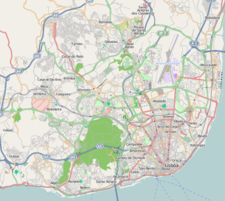| Central Mosque of Lisbon | |
|---|---|
Mesquita Central de Lisboa | |
 | |
| Religion | |
| Affiliation | Islam |
| Branch/tradition | Sunni |
| Location | |
| Location | Campolide, Lisbon, Portugal |
| Geographic coordinates | 38°44′7.97″N 9°9′30.70″W / 38.7355472°N 9.1585278°W |
| Architecture | |
| Architect(s) | António Maria Braga, João Paulo Conceição |
| Type | mosque |
| Completed | 1985 |
| Specifications | |
| Dome(s) | 2 |
| Minaret(s) | 4 |
The Central Mosque of Lisbon (Portuguese: Mesquita Central de Lisboa) is the main mosque of Lisbon, Portugal, serving the capital city's Islamic community. The mosque is Europe's third largest mosque outside of Turkey. The building was designed by the architects António Maria Braga, winner of the 2019 Rafael Manzano Prize, and João Paulo Conceição; its external features includes four minarets and two domes. The mosque contains reception halls, a prayer hall and an auditorium. The Central Mosque has formed a council to provide financial and others services to members of the local Muslim community.
YouTube Encyclopedic
-
1/3Views:18 0567 327412
-
The Central Mosque of Lisbon, Portugal | Mufti Abdul Wahab
-
History of Mesquita Central Lisbao | Central Masjid Lisbon | Mufti Abdul Wahab
-
Beautiful Adhan • Central Masjid of Lisbon • Qari Hudhaifa Khan
Transcription
History
Although permission to build the center was requested in 1966, it was not granted until 1978 after the 1973 oil crisis through which the Arab oil-producing nations gained increasing economic and political status. The structure was finally inaugurated in 1985.[1]
See also
References
- ^ Shireen Hunter (1 January 2002). Islam, Europe's Second Religion: The New Social, Cultural, and Political Landscape. Greenwood Publishing Group. p. 194. ISBN 978-0-275-97609-5.


